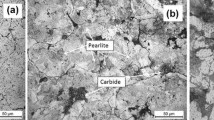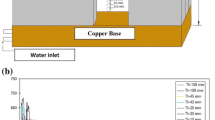Abstract
The influence of C and Si on pore morphology and tensile behavior of Fe–C–P–Si was investigated. The contribution of C on the morphology of pores was explained using thermodynamic formulation by incorporating the surface curvature effect. Thermodynamic analysis of the pore surface suggests that C is enriched at all regions within the pore whether its convex or concave regions, resulting in C coverage of the surface pore. The C coverage will reduce the surface energy without changing the pore’s morphology. Accordingly, C has no effect on surface rounding of pores. Compacted tensile test specimens of Fe–C–P–Si powder were made to produce elongated pores. Tensile testing shows the effect of the sintered density, microstructure, pore morphology, and grain boundary on the mechanical properties. It was found that ductility is affected by pore morphology and grain boundaries, but UTS is more affected by the sintered density and the matrix microstructure.








Similar content being viewed by others
References
P. Beiss, M. Dalgic, Structure property relationships in porous sintered steels. Mater. Chem. Phys. 67(1–3), 37–42 (2001)
S. Yoont, H. Lee, H. Ahn, H. Lee, C. Lee, Effects of sintering conditions on the mechanical properties of metal injection Molded 316L stainless steel. ISIJ Int. 43(1), 119–126 (2003)
B. Kubicki, Stress concentration at pores in sintered materials. Powder Metall. 38(4), 183–191 (1995)
J. Moon, Design and capabilities of PM components and materials. Powder Metall. 42(2), 204–218 (1999)
Y. Itoh, T. Harikou, K. Sato, H. Miura, Improvement of ductility for injection moulding Ti–6Al–4V alloy, in European Congress and Exhibition on Powder Metallurgy. European PM Conference Proceedings, vol. 4 (The European Powder Metallurgy Association, Shrewsbury, 2004), pp. 1–6
R. Zhang, J. Kruszewski, J. Lo, A study of the effects of sintering parameters on the microstructure and properties of PIM Ti6Al4V alloy. Powder Inject. Mould. Int. 2(2), 74–78 (2008)
J. Seuba, S. Deville, C. Guizard, A. Stevenson, Mechanical properties and failure behavior of unidirectional porous ceramics. Sci. Rep. 6, 24326 (2016). https://doi.org/10.1038/srep24326
W. James, Fatigue properties of ferrous P/M materials. Presented at P/M seminar, São Paulo, Brazil, October, Associacão Brasilelra de Metals, 1989
F. Puckert, F. Dai, K. Hanawa, T. Nakagawa, K. Akechi, Growth of graphite in sintered and carburized iron and iron–silicon compacts. Trans. Jpn. Inst. Metals 25(6), 382–389 (1984)
W. Khraisat, L. Nyborg, Grey iron microstructures via liquid-phase sintering. Int. J. Powder Metall. 41(6), 34–41 (2005)
W. Abu Jadayil, M. Alnaber, Assessment of fatigue life of Ni–Ti samples prepared by different techniques. Appl. Mech. Mater. 477–478, 1264–1268 (2013)
W. Abu Jadayil, Experimental investigation of solidification time effects on surface and subsurface aluminum casting defects. Int. Rev. Mech. Eng. 5(4), 569–576 (2011)
W. Abu Jadayil, Studying the effects of varying the pouring rate on the casting defects using nondestructive testing techniques. Jordan J. Mech. Ind. Eng. 5(6), 521–526 (2011)
W. Abu Jadayil, Revision of the recent heterogeneous solid object modeling techniques. Jordan J. Mech. Ind. Eng. 4(6), 779–788 (2010)
W. Abu Jadayil, Relative fatigue life estimation of cylindrical hollow rollers in general pure rolling contact. J. Tribotest 14, 27–42 (2008)
W. Abu Jadayil, D. Flugrad, Fatigue life investigation of solid and hollow rollers under pure normal loading. J. Tribotest 13, 165–181 (2007)
W. Abu Jadayil, N. Jaber, Numerical prediction of optimum hollowness and material of hollow rollers under combined loading. J. Mater. Des. 31(3), 1490–1496 (2009)
W. Abu Jadayil, W. Khraisat, Predicting the optimum hollowness of normally loaded cylindrical rollers using finite element analysis. J. Mater. Sci. Technol. 26(2), 176–183 (2010)
W. Abu Jadayil, M. Mohsen, Experimental investigation of self actuating traction drives with solid and hollow rollers. Int. Rev. Mech. Eng. 5(4), 637–645 (2011)
W. Khraisat, W. Abu Jadayil, Strengthening aluminum scrap by alloying with iron. Jordan J. Mech. Ind. Eng. 4(3), 372–377 (2010)
W. Khraisat, H. Borgstrom, L. Nyborg, W. Abu Jadayil, Optimising grey iron powder compacts. J. Powder Metall. 52(4), 291–297 (2009)
W. Khraisat, W. Abu Jadayil, N. Rawashdeh, H. Borgström, The role of phosphorus in pore rounding of sintered steels. Cogent Eng. 5(1452350), 1–12 (2018)
E. Kozeschnik, H. Bhadeshia, Influence of silicon on cementite precipitation in steels. Mater. Sci. Technol. 24(3), 343–347 (2008)
M. Orlandi, P. Suman, R. Silva, E. Arlindo, Carbothermal reduction synthesis: an alternative approach to obtain single-crystalline metal oxide nanostructures, in Recent Advances in Complex Functional Materials, Chapter 2 (Springer International Publishing AG, 2017), pp. 43–67. https://doi.org/10.1007/978-3-319-53898-3_2
K. Zumsande, N. Krasokha, S. Huth, S. Weber, W. Theisen, In situ investigation of the gas–solid interaction between high-alloyed steel powder and nitrogen by energy dispersive diffraction. J. Mater. Sci. 47(7), 3214–3226 (2012)
A. Taskinen, M. Tikkanen, G. Bockstiegel, Carbon deposition in iron powder compacts during de-lubrication processes. Scand. J. Metall. 10(2), 55–62 (1981)
O. Bergman, Studies of oxide reduction and nitrogen uptake in sintering of chromium-alloyed steel powder, Licentiate thesis Stockholm, Sweden, Universitets service US AB, 2008
M.P. Xu, J. Brown Jr., Mechanism of iron catalysis of carbon monoxide decomposition in refractories. J. Am. Ceram. Soc. 72(1), 110–115 (1989)
Author information
Authors and Affiliations
Corresponding author
Additional information
Publisher's Note
Springer Nature remains neutral with regard to jurisdictional claims in published maps and institutional affiliations.
Rights and permissions
About this article
Cite this article
Khraisat, W., Abu Jadayil, W. & Rawashdeh, N. The Effect of Carbon and Silicon Alloying Additions on the Morphology of Pores and Tensile Characteristics of Sintered Steels. Metallogr. Microstruct. Anal. 8, 182–188 (2019). https://doi.org/10.1007/s13632-019-00520-9
Received:
Accepted:
Published:
Issue Date:
DOI: https://doi.org/10.1007/s13632-019-00520-9




